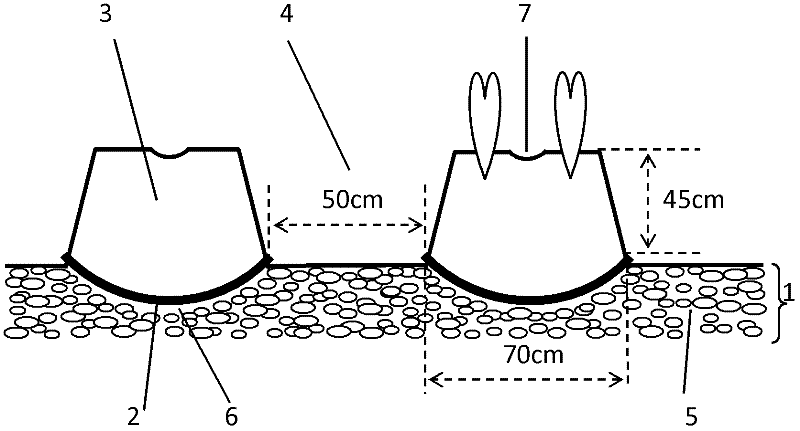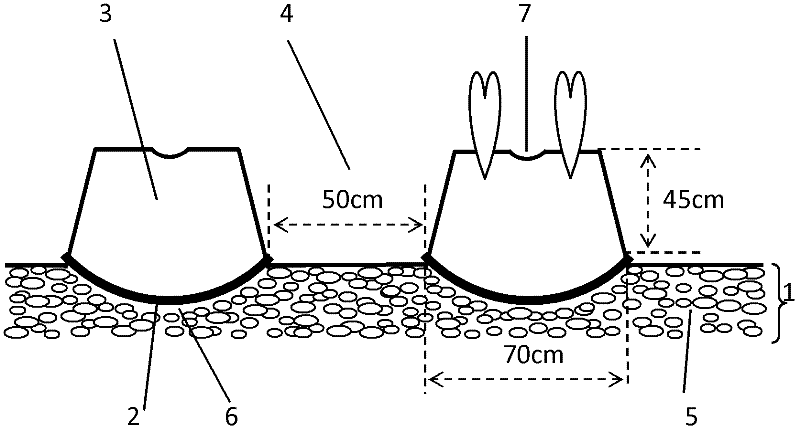Water-saving cultivating method and structure
A cultivation method and technology of cultivating ridges, applied in the field of agricultural cultivation, can solve the problems of unfavorable rapid promotion, high implementation cost, and various materials, and achieve the effects of easy implementation and promotion, saving water resources, and low cost
- Summary
- Abstract
- Description
- Claims
- Application Information
AI Technical Summary
Problems solved by technology
Method used
Image
Examples
Embodiment 1
[0038] Take the vegetables cultivated in the Gobi Desert in Akto County, Kezhou, Xinjiang as an example:
[0039] Cultivation structure such as figure 1 As shown, it includes a cultivation base layer 1, an 8 μm thick polyethylene film water-retaining layer 2 and a cultivation ridge 3 from bottom to top. Between the cultivation ridges 3 are naturally formed furrows 4; The gravel layer 5 and the fine sand soil layer 6 of the upper layer; a small irrigation ditch 7 is left in the center of the cultivation ridge 3 top; exposed.
[0040] Among them, the height of the cultivated ridge is about 45 cm, the width of the bottom of the ridge is about 70 cm, and the distance between the ridges is about 50 cm; the plastic film water retention layer is concave; two rows of vegetables are cultivated in each ridge.
[0041] The cultivation method is as follows:
[0042] 1) Level the ground, loosen the depth of about 30 cm, and use a sieve with an aperture of about 15 mm to sieve the loosen...
Embodiment 2
[0047] Take the cultivation of vegetables in coastal saline-alkali land in Shouguang City, Shandong Province as an example:
[0048] The height of the cultivated ridge is about 45 cm, the width of the bottom of the ridge is about 70 cm, and the distance between the ridges is about 50 cm; the water-retaining layer of plastic film is horizontal; two rows of vegetables are cultivated in each ridge.
[0049] The cultivation method is as follows:
[0050] 1) Loosen the soil, the direction of loosening is perpendicular to the direction of the cultivation ridge, the depth of loosening is about 20 cm, and the soil is moved to the ground more than 70 cm in front while loosening. After loosening and turning more than 70 centimeters (this is the position where the cultivation ridge is located, it is the width of the bottom of the cultivation ridge), the turned over ground is smooth and smooth, and covered with a plastic film with a width of 70 centimeters. Continue to loosen and turn 12...
Embodiment 3
[0055] Take the vegetables cultivated in the semi-arid area of Kangping County, Liaoning as an example:
[0056] Among them, the height of the cultivated ridge is about 45 cm, the width of the bottom of the ridge is about 70 cm, and the distance between the ridges is about 50 cm; the plastic film water retention layer is concave; two rows of vegetables are cultivated in each ridge.
[0057] The cultivation method is as follows:
[0058] The process of loosening the soil, laying the water-retaining layer, and building up the cultivation ridge is similar to "Example 2", but the difference is that when the plastic film is laid, the ground is processed into a concave arc surface, so that the bottom of the cultivation ridge looks like a shallow ditch.
[0059] Two rows of vegetables are cultivated on each ridge, and the cultivation period is 9 months. Varieties: tomato, strawberry.
[0060] Through the cultivation method of the present invention, the yield per mu is 5,831 kilog...
PUM
 Login to View More
Login to View More Abstract
Description
Claims
Application Information
 Login to View More
Login to View More - R&D
- Intellectual Property
- Life Sciences
- Materials
- Tech Scout
- Unparalleled Data Quality
- Higher Quality Content
- 60% Fewer Hallucinations
Browse by: Latest US Patents, China's latest patents, Technical Efficacy Thesaurus, Application Domain, Technology Topic, Popular Technical Reports.
© 2025 PatSnap. All rights reserved.Legal|Privacy policy|Modern Slavery Act Transparency Statement|Sitemap|About US| Contact US: help@patsnap.com


